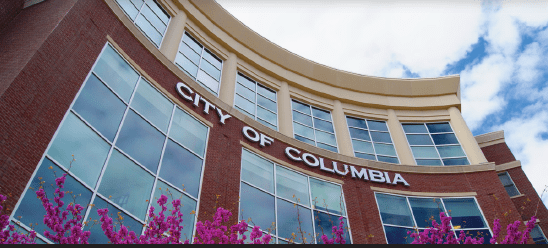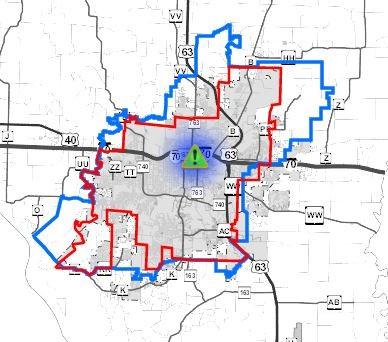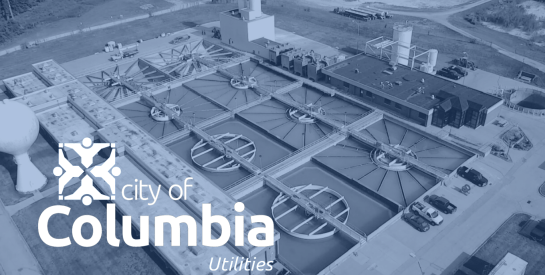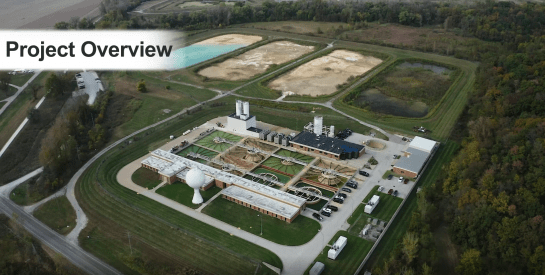Water Utility
About Water
We rely on the City’s water system to treat and transport water to 51,000 customers (a population of over 126,000 people) residing and working in our 89 square mile service area. In order to proactively respond to customer demands through 2033, Columbia Water & Light contracted with Jacobs Engineering Group to analyze how to best provide water service. See the full Long Range Water System Studyopens PDF file for details on recommended Improvement Projects.
- Water rates
- With the passage of the Fiscal Year 2023 budget, new water rates go into effect beginning with bills issued after Oct. 1, 2022. Learn more.opens PDF file
Utility outage map
Utility outage map
Use the outage viewer to locate utility outages and boil advisories.
Boil orders & advisories
For more information on boil orders, please see your Boil Advisories and Boil Orders page.
Water quality
Water quality
Columbia’s water is tested more frequently and more thoroughly than is required by law. The well water is monitored for any possibility of contamination and multiple tests are run daily throughout the treatment process. The Utility tests samples from more than 40 locations throughout Columbia. Columbia’s drinking water meets or exceeds all quality standards set by the Federal Environmental Protection Agency and the Missouri Department of Natural Resources.
For detailed information, please see the City of Columbia 2022 Water Quality Reportopens PDF file and the Source Water Protection Planopens PDF file . You can also view the City of Columbia 2022 Water Quality Report on the Department of Natural Resources opens PDF file website.
Recent MDNR testing results and reportable events:
Water supply
Water supply
Columbia’s water is pumped from wells that tap into a water-filled bed of sand and gravel beneath the bottom land bordering the Missouri River just southwest of the city. Long ago, melting glaciers washed sand, gravel and boulders downstream and left thick deposits along the course of the river. This geological formation is an alluvium and when saturated with water becomes an alluvial aquifer. Water slowly moves through the aquifer, which acts as a natural filtration system. Forty-four billion gallons of water fill the area which is constantly replenished by groundwater sources. The wells average 110 feet deep, penetrating the aquifer near its bottom.
The Integrated Water Resource Plan (IWRP) Final Reportopens PDF file was completed in March 2017 and will guide the best combination of strategies for ensuring a sustainable and cost-efficient water supply.
U.S. geological survey resources
In 1992, an agreement among the USGS, the City of Columbia and the Missouri Department of Conservation began groundwater monitoring in the McBaine Bottoms around the City’s wetland treatment units and on the Eagle Bluffs Conservation property.
The objective of these studies is to monitor the water quality throughout the McBaine Bottoms, to track changes in groundwater quality in the vicinity of the public supply well field and the Eagle Bluffs Conservation Area, and to provide the City with the information needed to protect the well field and ensure good quality drinking water.
Interactive USGS map to access water data from Columbia wells
Water resources investigation reports
2008: Ground-Water Flow, 2004-07, and Water Quality, 1992-2007, in McBaine Bottoms, Columbia, Missouri
Water treatment
Water treatment
- Aeration: At the treatment plant, the water first flows through aerators and is exposed to air that is drawn through the aerators by fans. This oxidation of the well water reduces levels of iron, carbon dioxide and hydrogen sulfide that are naturally found in the water.
- Softening: Lime is then added to the aerated water, and a chemical reaction occurs between the lime and the calcium and magnesium dissolved in the well water. Heavy, insoluble particles of calcium and magnesium form and settle to the bottom of the softening basins, and as it accumulates, it is piped to storage lagoons. This process physically removes 50 percent of the hardness causing minerals from the water. Softened water enables you to use less laundry detergent and reduces scale formed in water heaters and pipes.
- Filtration: Any particles remaining in the water after the softening process are filtered through layers of anthracite coal and sand. Chlorine may be added before or after filtration to prevent bacterial growth. Fluoride is added to meet Environmental Protection Agency recommendations and helps improve dental health.
- Disinfection: Water must be disinfected to prevent bacterial growth and prevent disease causing illnesses like typhoid, hepatitis and cholera. The disinfection method used in Columbia allows for disinfection of the water through the distribution system all the way to the faucet. The Columbia Water Treatment Plant first disinfects the water with chlorine, than adds ammonia, forming chloramine. Chloramine is a common disinfectant that has been used for the last 90 years. There are 0.6 milligrams of ammonia added per liter of water. For comparison, this would be similar to adding six grains of table salt to a one gallon container of water. More information on disinfection methods can be found in this 2009 reportopens PDF file from the University of Missouri’s Department of Civil and Environmental Engineering and the Missouri Water Resource Research Center.
For more details on Columbia’s Water treatment processopens PDF file with pictures, follow the link.
Water distribution
Water distribution
Softened, filtered water is pumped from the water treatment plant to reservoirs at the West Ash, South Pump and Hillsdale pumping stations. The water is then pumped throughout the city to consumers. Water is stored in three water towers that provide capacity for peak water use and fire fighting.
- Water Leaks
- Backflow Preventers
- Email test report submissions to [email protected]create new email
The following subdivisions are urged to stick to an Irrigation Scheduleopens PDF file this summer: Bradbury Estates, Creek’s Edge, Thornbrook, Steeplechase, and Wyndham Ridge
Engineering
Engineering
McBaine Water Treatment Plant Improvement Project
Columbia Water & Light’s McBaine Water Treatment Plant (WTP) Improvement Project will restore the plant’s capacity to treat 32 million gallons of water per day and include rehabilitation and replacement projects that will enhance the performance and extend the life of this critical facility.
The sale of the bond from the voter-approved 2018 Water Ballot Initiative that will fund the project closed Oct. 26, 2023.
With the sale of the bond, an adjusted customer base charge will go into effect beginning with the first billing cycle in November 2023. For more information, visit our FAQ page:
Construction service manual
Rules, Regulations and Policy relating to Installation and Extension of Water and Electric Facilities
Facilities connection requirements
This document outlines the requirements for generation, transmission, and end-use facilities of customers to be connected to the Columbia Water & Light Department (CWLD) electric system. Its purpose is to promote safety of people and equipment, compatibility between customer facilities and CWLD facilities, and maintenance of reliability of the regional electric system when a customer requests an interconnection with CWLD. It complies with the requirements of the NERC Standard FAC-001 and FAC-002.
Water main construction specification
This document is provided for developers constructing water mains within the City of Columbia’s water territory. The official, signed copy is on file with the Columbia Water & Light Engineering Division and might include updates that have not been posted on the web site yet. The web document is only meant as a reference.
Contacts
Search:
Activity & Recreation Center (ARC)
Phone: 573.874.7700opens phone dialer
Address:
1701 W. Ash St.
Columbia, MO 65203
Public Health & Human Services
Phone: 573.817.6441opens phone dialer
Alternate Phone: 573.874.7781opens phone dialer
Fax: 573.874.7756opens phone dialer
Email: Health@CoMo.gov
Address:
1005 W. Worley St
Columbia, Missouri 65203
Title: Mayor
Term Expires: April 2025
Phone: 573.874.7222opens phone dialer
Email: Mayor@CoMo.gov
Address:
City of Columbia, Missouri
701 E Broadway
P.O. Box 6015
Columbia, Missouri, 65205
Title: Ward 1 Council Member
Term Expires: April 2026
Phone: 573.864.7222opens phone dialer
Email: CityClerk@CoMo.gov
Address:
City of Columbia, Missouri
701 E Broadway
P.O. Box 6015
Columbia, Missouri, 65205
Title: Ward 2 Council Member
Term Expires: April 2027
Phone: 573.823.2274opens phone dialer
Email: Ward2@CoMo.gov
Address:
City of Columbia, Missouri
701 E Broadway
P.O. Box 6015
Columbia, Missouri, 65205
Title: Ward 3 Council Member
Term Expires: April 2025
Phone: 573.864.4976opens phone dialer
Email: Ward3@CoMo.gov
Address:
City of Columbia, Missouri
701 E Broadway
P.O. Box 6015
Columbia, Missouri, 65205
Title: Ward 4 Council Member
Term Expires: April 2025
Phone: 573.999.0897opens phone dialer
Email: Ward4@CoMo.gov
Address:
City of Columbia, Missouri
701 E Broadway
P.O. Box 6015
Columbia, Missouri, 65205
Title: Ward 5 Council Member
Term Expires: April 2026
Phone: 573.864.4972opens phone dialer
Email: Ward5@CoMo.gov
Address:
City of Columbia, Missouri
701 E Broadway
P.O. Box 6015
Columbia, Missouri, 65205
Title: Ward 6 Council Member
Term Expires: April 2024
Phone: 573.864.4971opens phone dialer
Email: Ward6@CoMo.gov
Address:
City of Columbia, Missouri
701 E Broadway
P.O. Box 6015
Columbia, Missouri, 65205
Phone: 573.874.2489opens phone dialer
Email: OCA@CoMo.gov
Address:
1 South 7th Street
P. O. Box 6015
Columbia, MO 65205
Phone: 573.874.2489opens phone dialer
Email: Planning@CoMo.gov
Address:
701 E Broadway
Columbia, Missouri 65201
Title: Engagement and Public Communications Manager
Phone: 573.874.7438opens phone dialer
Email: Sydney.Olsen@CoMo.gov
Address:
600 Big Bear Boulevard, Columbia, MO 65202
Address:
2300 E. Walnut Street
Columbia, MO
Address:
100 N Old 63
Address:
N William St
Columbia, MO
Address:
1905 Hillcrest Dr.
Parks and Recreation Department General Office (a.k.a. Gentry Building)
Phone: 573.874.7460opens phone dialer
Fax: 573.874.7640opens phone dialer
Email: ParksAndRec@CoMo.gov
Address:
1 South 7th Street
P. O. Box 6015
Columbia, MO 65205
Phone: 573.874.6259opens phone dialer
Fax: 573.442.8828opens phone dialer
Email: HumanRights@CoMo.gov
Address:
701 E. Broadway, 2nd Floor
P.O. Box 6015
Columbia, MO 65205
Address:
2900 East Nifong Boulevard
Columbia, MO 65201
Title: Constituent Services and Legislative Affairs Administrator
Phone: 573.874.7646opens phone dialer
Email: Stacey.Weidemann@CoMo.gov
Address:
902 Range Line St.
Phone: 573.442.6131opens phone dialer
Address:
2104 Hillcrest Drive,
Columbia, MO 65201
Albert-Oakland Family Aquatic Center
Phone: 573.474.5331opens phone dialer
Alternate Phone: 573.874.7460opens phone dialer
Phone: 573.817.5015opens phone dialer
Address:
5001 E Meyer Industrial Drive, Columbia, MO 65203
Douglass Family Aquatic Center
Phone: 573.442.5019opens phone dialer
Alternate Phone: 573.874.7460opens phone dialer
Title: Information Center Supervisor
Phone: 573.874.7418opens phone dialer
Email: Kerri.Seversen@CoMo.gov
Address:
1201 Paquin St.
Phone: 573.874.7378opens phone dialer
Fax: 573.874.7761opens phone dialer
Email: Business.license@CoMo.Gov
Address:
PO Box 6015, Columbia, MO, 65205
Phone: 573.874.7201opens phone dialer
Fax: 573.875.3159opens phone dialer
Address:
1507 Bus. Loop 70W
Columbia, MO 65202
Phone: 573.474.7878opens phone dialer
Alternate Phone: 573.874.7460opens phone dialer
Title: Community Recreation Manager
Phone: 573.874.6378opens phone dialer
Email: Camren.Cross@CoMo.gov
Phone: 573.874.7244opens phone dialer
Fax: 573.874.7760opens phone dialer
Email: Darcie.Clark@CoMo.gov
Address:
500 E Walnut, Suite 108
Address:
2002 Grindstone Pkwy.
Stephens Lake Beach (Unguarded) and Spraygrounds
Address:
100 Old 63 N.
Molly Thomas Bowden Neighborhood Policing Center
Address:
1204 International Drive,
Columbia, MO 65202
Phone: 573.874.7384opens phone dialer
Fax: 573.874.7757opens phone dialer
Email: Health@CoMo.gov
Address:
1005 W. Worley St.
Phone: 573.874.2489opens phone dialer
Alternate Phone: 573.441.5574opens phone dialer
Email: Info@CoMo.gov
Address:
300 S Providence Rd
Columbia, MO 65203
Title: Parks and Recreation
Phone: 573.874.7460opens phone dialer
Email: ParksandRec@CoMo.gov
Address:
1 South 7th Street
P. O. Box 6015
Columbia, MO 65205
Title: Lieutenant, Professional Standards
Phone: 573.874.7652opens phone dialer
Email: Clinton.Sinclair@CoMo.gov
Title: Assistant City Manager
Phone: 573.874.2489opens phone dialer
Email: Carol.Rhodes@CoMo.gov
Address:
City Hall, Second Floor
701 E Broadway
P.O. Box 6015
Columbia, Missouri, 65203
Phone: 573.817.5024opens phone dialer
Email: DisabilityServices@CoMo.gov
Address:
City of Columbia, Law Department
ADA Coordinator
701 East Broadway, 2nd Floor
P.O. Box 6015
Columbia, MO 65205
Title: IT Director
Phone: 573.874.7500opens phone dialer
Email: Cityit1@CoMo.gov
Address:
701 E Broadway
Columbia, Missouri 65201
Address:
1900 Blue Ridge Road
Phone: 573.874.2489opens phone dialer
Email: Cityclerk@CoMo.gov
Address:
701 E Broadway
Columbia MO, 65202
Phone: 573.874.6338opens phone dialer
Email: Cmo@CoMo.gov
Address:
City Hall, Second Floor
701 E Broadway
P.O. Box 6015
Columbia, Missouri 65205
Phone: 573.874.7249opens phone dialer
Alternate Phone: 573.874.7356opens phone dialer
Fax: 573.874.7597opens phone dialer
Email: Health@CoMo.gov
Prevention, Disease Intervention & Case Management
Phone: 573.874.7408opens phone dialer
Alternate Phone: 833.402.1458opens phone dialer
Email: SexualHealth@CoMo.gov
Title: Assistant Chief, North Patrol
Phone: 573.874.7407opens phone dialer
Email: Jeremiah.Hunter@CoMo.gov
Title: Assistant Chief, Investigative Operations Support
Email: Lance.Bolinger@CoMo.gov
Phone: 573.817.6430opens phone dialer
Email: HumanServices@CoMo.gov
Address:
1005 W. Worley St.
Columbia, MO 65203
Phone: 573.442.8303opens phone dialer
Address:
500 E Walnut St
Columbia, MO 65201
Phone: 573.874.7346opens phone dialer
Email: Health@CoMo.gov
Address:
1005 W. Worley St.
Columbia, MO 65203
Phone: 573.874.7391opens phone dialer
Alternate Phone: 573.874.7450opens phone dialer
Fax: 573.874.7446opens phone dialer
Email: Fire@CoMo.gov
Address:
201 Orr St
Columbia, MO 65201
Title: Public Health Planning Manager
Phone: 573.874.6331opens phone dialer
Email: Michelle.Shikles@CoMo.gov
Household Hazardous Waste Collection
Phone: 573.874.2489opens phone dialer
Email: Cc_forms@CoMo.gov
Address:
1313 Lakeview
Columbia, MO 65201
Phone: 573.874.7500opens phone dialer
Email: Cityit1@CoMo.gov
Address:
701 E Broadway
Columbia, Missouri 65201
Parkside Drive Yard Waste Drop-off Center
Phone: 573.874.2489opens phone dialer
Address:
Parkside Drive
Phone: 573.874.7223opens phone dialer
Fax: 573.442.8828opens phone dialer
Address:
701 E. Broadway, 2nd Floor
P.O. Box 6015
Columbia, MO 65205
Phone: 573.874.7230opens phone dialer
Fax: 573.874.7531opens phone dialer
Email: MunicipalCourt@CoMo.gov
Address:
600 E. Broadway
Columbia, MO 65203
Title: Prevention and Investigation Manager
Phone: 573.817.6402opens phone dialer
Email: Tracey.Bathe@CoMo.gov
Office of Neighborhood Services
Phone: 573.817.5050opens phone dialer
Alternate Phone: 573.874.7339opens phone dialer
Email: Neighborhood@CoMo.gov
Address:
701 Broadway
Columbia, MO, 65201
Title: Senior Administrative Supervisor (Administration)
Phone: 573.874.7347opens phone dialer
Email: Dana.Vaughn@CoMo.gov
Phone: 573.874.7652opens phone dialer
Email: Policepio@CoMo.gov
Address:
600 E. Walnut Street
Columbia, MO 65201
Title: Administrative Supervisor (Clinical Services)
Phone: 573.874.7357opens phone dialer
Email: Janet.Dutton@CoMo.gov
Capen Park Yard Waste Drop-off Center
Phone: 573.874.2489opens phone dialer
Address:
1600 Capen Park Dr, Columbia, MO 65201
Phone: 573.874.2489opens phone dialer
Email: Pubw@CoMo.gov
Address:
701 E Broadway
Columbia, Missouri 65201
Title: Creative Services and Marketing Manager
Phone: 573.874.7330opens phone dialer
Email: Brian.Adkisson@CoMo.gov
Title: Public Information Specialist
Address:
400 N Providence Rd
Columbia, MO 65203
Phone: 573.874.7380opens phone dialer
Email: UCS@CoMo.gov
Address:
City of Columbia, Utility Customer Service, PO Box 6015, Columbia, MO, 65205
Phone: 573.874.7499opens phone dialer
Fax: 573.874.7546opens phone dialer
Email: Volunteer@CoMo.gov
Address:
P.O. Box 6015
Columbia, MO 65205
Title: Transload Operations Supervisor
Phone: 573.441.5561opens phone dialer
Email: David.Dick@CoMo.gov
Title: Accounts Payable Contact Vendors M-Z
Phone: 573.874.7692opens phone dialer
Email: Accountspayable@CoMo.gov
Title: Recreation Services Manager
Phone: 573.874.7572opens phone dialer
Email: Erika.Coffman@CoMo.gov
Central Missouri Humane Society
Phone: 573.443.7387opens phone dialer
Address:
616 Big Bear Blvd.
Columbia, MO 65202
Title: Railroad Operations
Phone: 573.441.5564opens phone dialer
Alternate Phone: 573.864.2171opens phone dialer
Email: Matthew.Sabath@CoMo.gov
Title: Park Planning & Development Superintendent
Phone: 573.874.7203opens phone dialer
Email: Mike.snyder@CoMo.gov
Title: City Manager
Phone: 573.874.2489opens phone dialer
Email: Cmo@CoMo.gov
Address:
City Hall, Second Floor
701 E Broadway
P.O. Box 6015
Columbia, Missouri, 65203
Address:
400 N. Providence Rd.
Title: Assistant City Manager
Email: Matt.unrein@CoMo.gov
Address:
City Hall, Second Floor
701 E. Broadway
P.O. Box 6015
Columbia, Missouri, 65203
Phone: 573.874.7229opens phone dialer
Fax: 573.874.7533opens phone dialer
Email: CityProsecutor@CoMo.gov
Address:
600 E. Broadway
P. O. Box 6015
Columbia, MO 65205-6015
Title: Diversity, Equity, and Inclusion Administrator, LGBTQ+ Liaison
Phone: 573.289.5975opens phone dialer
Email: D'andre.thompson@CoMo.gov
Gans Creek Cross Country Course
Address:
3350 E. Gans Road
Title: Public Information Specialist
Phone: 425.209.6344opens phone dialer
Email: Christian.Tabak@CoMo.gov
Title: Entrepreneurship Coordinator
Phone: 573.441.5546opens phone dialer
Alternate Phone: 573.268.5596opens phone dialer
Email: Jay.Sparks@CoMo.gov
Phone: 573.874.2489opens phone dialer
Email: Cc_forms@CoMo.gov
Address:
701 E. Broadway
P.O. Box 6015
Columbia, MO 65205
Phone: 573.874.7239opens phone dialer
Email: Planning@CoMo.gov
Address:
701 Broadway
Columbia, MO, 65201
Title: Environmental Education Coordinator
Phone: 573.817.6447opens phone dialer
Email: Michael.heimos@CoMo.gov
Title: Environmental Program Coordinator
Phone: 573.441.5513opens phone dialer
Email: Kevin.carpenter@CoMo.gov
Convention & Visitors Bureau – Special Events
Phone: 573.817.5052opens phone dialer
Email: Specialevents@CoMo.gov
Address:
300 S. Providence Road, Columbia, MO 65203
Diversity, Equity and Inclusion Administrator
Title: Diversity, Equity and Inclusion Administrator
Phone: 573.874.6259opens phone dialer
Email: HumanRights@CoMo.gov
Phone: 573.874.7488opens phone dialer
Email: HumanServices@CoMo.gov
Address:
1005 W. Worley St.
Columbia, MO 65203
Title: Environmental Health Supervisor
Phone: 573.874.7382opens phone dialer
Email: Chrystal.Smart@CoMo.gov
Phone: 573.817.6430opens phone dialer
Email: SocialServices@CoMo.gov
Address:
1005 W. Worley St.
Columbia, MO 65203
Address:
1615 Business Loop 70 W
Columbia, MO 65202
Address:
3350 Waco Rd
Columbia, MO 65202
Title: Assistant Chief, South Patrol
Phone: 573.874.7607opens phone dialer
Email: Mark.Fitzgerald@CoMo.gov
Phone: 573.442.5019opens phone dialer
Alternate Phone: 573.874.7460opens phone dialer
Address:
Martin Luther King, Jr. Memorial at Battle Garden
800 W. Stadium Blvd.
Columbia, MO 65203
Title: Parks and Recreation Director
Phone: 573.874.6398opens phone dialer
Email: Gabe.Huffington@CoMo.gov
Phone: 573.874.7474opens phone dialer
Email: Bldg-inspection@CoMo.gov
Address:
701 E Broadway
Columbia, MO, 65201
Address:
Grissum Building, 1313 Lakeview Ave.
Address:
2104 Hillcrest Drive
Press Releases
4/8/2024 – City of Columbia Water & Light recognized as a Reliable Public Power Provider
3/18/2024 – City of Columbia Utilities to resume utility disconnects
2/26/2024 – City of Columbia Water & Light earns Water Fluoridation Quality Award
2/23/2024 – City of Columbia to resume residential curbside recycling collection March 18
2/23/2024 – Road closure scheduled on Garth Avenue beginning Feb. 26





